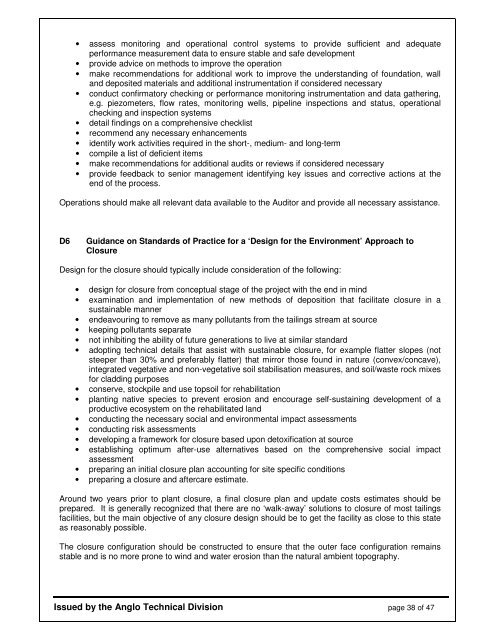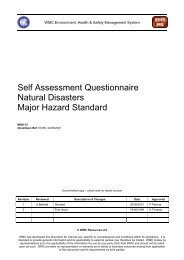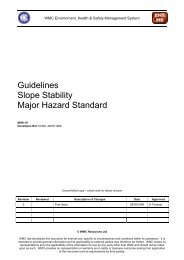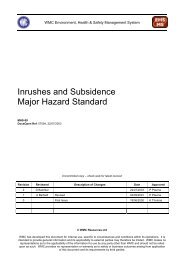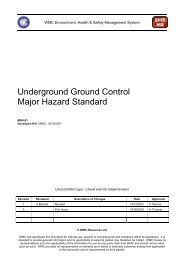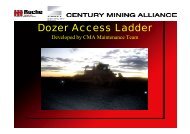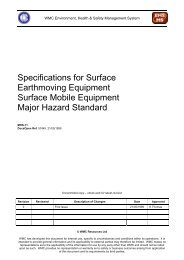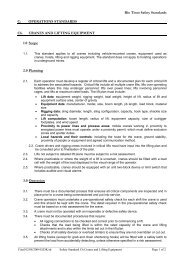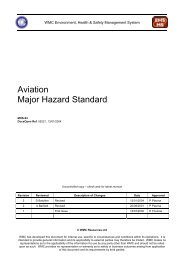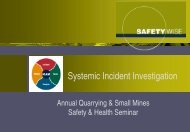SAFETY, HEALTH & ENVIRONMENT BULLETIN - MIRMgate
SAFETY, HEALTH & ENVIRONMENT BULLETIN - MIRMgate
SAFETY, HEALTH & ENVIRONMENT BULLETIN - MIRMgate
You also want an ePaper? Increase the reach of your titles
YUMPU automatically turns print PDFs into web optimized ePapers that Google loves.
• assess monitoring and operational control systems to provide sufficient and adequate<br />
performance measurement data to ensure stable and safe development<br />
• provide advice on methods to improve the operation<br />
• make recommendations for additional work to improve the understanding of foundation, wall<br />
and deposited materials and additional instrumentation if considered necessary<br />
• conduct confirmatory checking or performance monitoring instrumentation and data gathering,<br />
e.g. piezometers, flow rates, monitoring wells, pipeline inspections and status, operational<br />
checking and inspection systems<br />
• detail findings on a comprehensive checklist<br />
• recommend any necessary enhancements<br />
• identify work activities required in the short-, medium- and long-term<br />
• compile a list of deficient items<br />
• make recommendations for additional audits or reviews if considered necessary<br />
• provide feedback to senior management identifying key issues and corrective actions at the<br />
end of the process.<br />
Operations should make all relevant data available to the Auditor and provide all necessary assistance.<br />
D6<br />
Guidance on Standards of Practice for a ‘Design for the Environment’ Approach to<br />
Closure<br />
Design for the closure should typically include consideration of the following:<br />
• design for closure from conceptual stage of the project with the end in mind<br />
• examination and implementation of new methods of deposition that facilitate closure in a<br />
sustainable manner<br />
• endeavouring to remove as many pollutants from the tailings stream at source<br />
• keeping pollutants separate<br />
• not inhibiting the ability of future generations to live at similar standard<br />
• adopting technical details that assist with sustainable closure, for example flatter slopes (not<br />
steeper than 30% and preferably flatter) that mirror those found in nature (convex/concave),<br />
integrated vegetative and non-vegetative soil stabilisation measures, and soil/waste rock mixes<br />
for cladding purposes<br />
• conserve, stockpile and use topsoil for rehabilitation<br />
• planting native species to prevent erosion and encourage self-sustaining development of a<br />
productive ecosystem on the rehabilitated land<br />
• conducting the necessary social and environmental impact assessments<br />
• conducting risk assessments<br />
• developing a framework for closure based upon detoxification at source<br />
• establishing optimum after-use alternatives based on the comprehensive social impact<br />
assessment<br />
• preparing an initial closure plan accounting for site specific conditions<br />
• preparing a closure and aftercare estimate.<br />
Around two years prior to plant closure, a final closure plan and update costs estimates should be<br />
prepared. It is generally recognized that there are no ‘walk-away’ solutions to closure of most tailings<br />
facilities, but the main objective of any closure design should be to get the facility as close to this state<br />
as reasonably possible.<br />
The closure configuration should be constructed to ensure that the outer face configuration remains<br />
stable and is no more prone to wind and water erosion than the natural ambient topography.<br />
Issued by the Anglo Technical Division page 38 of 47


